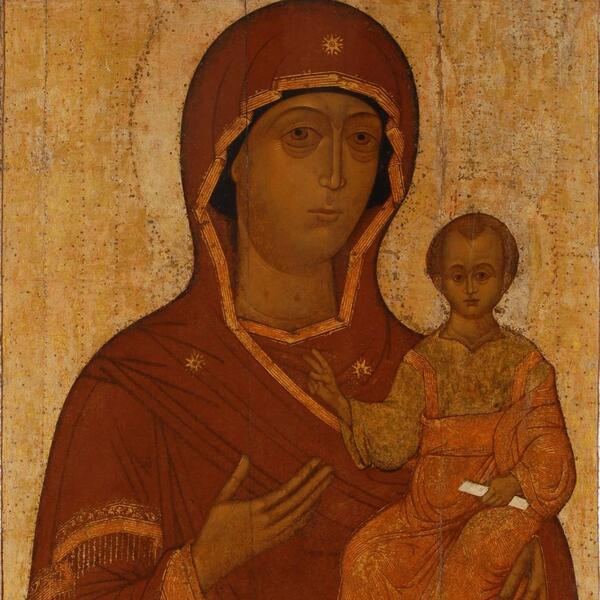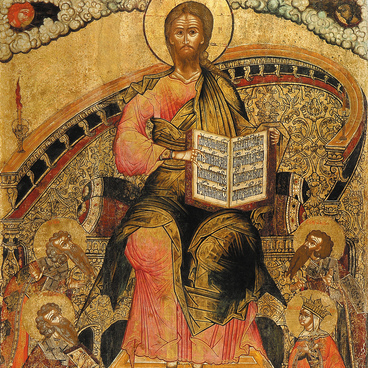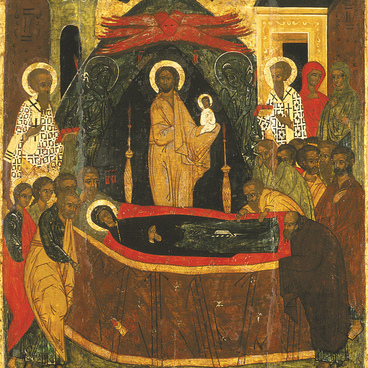Our Lady of Smolensk is one of the most solemn images of the Mother of God in the Orthodox iconographic tradition. It belongs to the Byzantine style of Hodegetria or Our Lady of the Way. Similar to the Eleusa, Our Lady of Smolensk holds the Child Jesus in her arms. Jesus raises his right hand in a blessing gesture while with his left hand he holds a scroll or, in some versions, a book. Apart from the half-length depiction like in this case, this image can also be used in full-length and chest-length icons.
This depiction has significant differences from the Eleusa. The icon aims to emphasize not the endless love between the Mother and the Son, but the adoration of the Heavenly King and Judge who has come to our world. Instead of his Mother, Jesus is looking directly at the viewer. The Mother of God is also depicted frontally, her head slightly inclined. Pointing at Christ, she focuses the viewer’s attention and prayers on him.
This icon is believed to have originated from the Hodegetria of Blachernae that was painted by Saint Luke the apostle during the lifetime of the Everlasting Virgin and kept in Constantinople until the 15th century. This image was popular in Byzantium and became venerated in Russia where the iconographic tradition was developed based on Byzantine art. In 1046, Constantine IX Monomachos chose this icon to bless the marriage of his daughter Anna and Prince Vsevolod, the son of Yaroslav the Wise. This is how the venerated icon came to Russia. At the very beginning of the 12th century, Vladimir Monomakh ordered to place this icon in the Cathedral Church of the Dormition in Smolensk. It became known as the Hodegetria of Smolensk. In 1239, when Batu Khan tried to attack the city, he was staved off with the help of prayers to this icon.
There are several versions as to how this icon ended up in the Annunciation Cathedral in Moscow. According to one of them, Prince Vasily the Blind received it as a gift from a certain man named Svilkoldovich who plundered Smolensk on his way from Lithuania to Moscow. Another version says that the icon came to Sophia, the wife of Prince Vasily I, from her father Vytautas of Lithuania. Finally, according to the third story, in the early 15th century, it was taken by Prince Georgy Svyatoslavovich who left Smolensk and took the icon along trying to protect it from the Lithuanians. In 1456, Vasily the Blind heeded the request of Misail, the Bishop of Smolensk, and returned the venerated icon.
When Smolensk entered the Grand Duchy of Moscow in 1514, the Hodegetria of Smolensk became revered all over Russia. This was also when numerous copies of this icon were made.
This depiction has significant differences from the Eleusa. The icon aims to emphasize not the endless love between the Mother and the Son, but the adoration of the Heavenly King and Judge who has come to our world. Instead of his Mother, Jesus is looking directly at the viewer. The Mother of God is also depicted frontally, her head slightly inclined. Pointing at Christ, she focuses the viewer’s attention and prayers on him.
This icon is believed to have originated from the Hodegetria of Blachernae that was painted by Saint Luke the apostle during the lifetime of the Everlasting Virgin and kept in Constantinople until the 15th century. This image was popular in Byzantium and became venerated in Russia where the iconographic tradition was developed based on Byzantine art. In 1046, Constantine IX Monomachos chose this icon to bless the marriage of his daughter Anna and Prince Vsevolod, the son of Yaroslav the Wise. This is how the venerated icon came to Russia. At the very beginning of the 12th century, Vladimir Monomakh ordered to place this icon in the Cathedral Church of the Dormition in Smolensk. It became known as the Hodegetria of Smolensk. In 1239, when Batu Khan tried to attack the city, he was staved off with the help of prayers to this icon.
There are several versions as to how this icon ended up in the Annunciation Cathedral in Moscow. According to one of them, Prince Vasily the Blind received it as a gift from a certain man named Svilkoldovich who plundered Smolensk on his way from Lithuania to Moscow. Another version says that the icon came to Sophia, the wife of Prince Vasily I, from her father Vytautas of Lithuania. Finally, according to the third story, in the early 15th century, it was taken by Prince Georgy Svyatoslavovich who left Smolensk and took the icon along trying to protect it from the Lithuanians. In 1456, Vasily the Blind heeded the request of Misail, the Bishop of Smolensk, and returned the venerated icon.
When Smolensk entered the Grand Duchy of Moscow in 1514, the Hodegetria of Smolensk became revered all over Russia. This was also when numerous copies of this icon were made.



